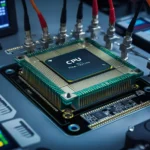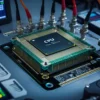In the world of computer hardware, few components spark as much excitement and speculation as graphics cards. As the backbone of high-definition gaming, professional rendering, and AI workloads, these pieces of hardware have become increasingly complex and powerful over the years. With major players like NVIDIA, AMD, and Intel constantly pushing the boundaries of performance and technology, understanding the latest trends in graphics cards is essential for both gamers and professionals alike. In this article, we’ll delve into the latest graphics cards released in 2023, highlighting their innovations, industry insights, performance metrics, and what the future holds for this critical segment in the tech landscape.
The Current Landscape of Graphics Cards
As of 2023, the graphics card market continues to be dominated by NVIDIA and AMD, with Intel making strides through its Arc series. Each brand has introduced next-generation graphics cards equipped with cutting-edge technologies and innovations aimed at enhancing performance, power efficiency, and overall user experience.
NVIDIA’s Reinvention with the RTX 40 Series
NVIDIA’s RTX 40 series, particularly the RTX 4090 and RTX 4080, has established itself as a formidable force in the realm of graphics cards. Leveraging the Ada Lovelace architecture, these GPUs provide a significant leap in performance compared to their predecessors.
The hallmark of the RTX 40 series is its focus on ray tracing and AI-enhanced graphics. Utilizing the Tensor Core technology and advanced DLSS (Deep Learning Super Sampling) capabilities, these cards can render stunning visuals at high frame rates, even in demanding environments. The latest DLSS 3 allows for frame generation, which can dramatically boost performance and create a more fluid gaming experience. The card not only shines in gaming but also excels in creative and professional environments, where rendering times can have significant implications on productivity.
AMD’s RDNA 3 Architecture
AMD’s RDNA 3 architecture has set a high bar for the red team with the Radeon RX 7900 XTX and RX 7900 XT models. Focused on performance per watt, the RDNA 3 leverages a chiplet design that allows for increased efficiency and scalability.
The new features, including Fluid Motion Frames for smoother gameplay and enhanced ray tracing, position AMD as a serious competitor. While they may not match NVIDIA’s dominance in ray tracing performance just yet, AMD’s engineering prowess shines through in its ability to provide great gaming performance at a more accessible price point. This approach is part of AMD’s strategy to challenge NVIDIA’s stronghold, leading to well-performing cards like the RX 7900 XTX, which caters to gamers seeking high performance without breaking the bank.
Intel’s Game Plan with Arc Graphics
Intel’s entry into the discrete graphics card market with its Arc graphics range has sparked curiosity as well as caution among tech enthusiasts. The Arc A770 and A750 demonstrated Intel’s commitment to developing competitive GPUs, emphasizing features like Xe Super Sampling (XeSS) and integrated AI capabilities.
Though Intel initially struggled with driver stability and performance, updates and optimizations have improved much since their launch. Their competitive prices and unique offerings for media creators have illuminated a potential future in professional and gaming applications. Intel seems poised for an upward trajectory as it continues to refine its architecture and software to match the expectations set by its competitors.
Technical Innovations Driving the Graphics Card Industry
The evolution of graphics cards is marked not just by raw performance but also by groundbreaking innovations that fundamentally alter the gaming and computational experience.
Ray Tracing and AI Integration
Ray tracing has become a standard benchmark of modern graphics performance, allowing for significantly realistic visual effects by simulating light paths. NVIDIA was the pioneer in this space, introducing hardware-based ray tracing capabilities with its Turing architecture and refining it with Ada Lovelace.
AI integration is reshaping how games are rendered and experienced. Technologies such as DLSS from NVIDIA and XeSS from Intel enable the construction of high-resolution images from lower resolution game data on-the-fly, resulting in significant performance boosts. AMD’s FSR (FidelityFX Super Resolution) continues to evolve as a strong competitor, ensuring that the battle among manufacturers leads to consistently improved graphics fidelity and performance.
VRAM and Memory Architecture
Memory bandwidth is a critical performance factor in graphics cards. The introduction of GDDR6X memory in NVIDIA cards and the enhanced memory architecture of AMD’s RDNA 3 allows these new GPUs to process large textures and high-resolution frames effectively.
Graphics cards are increasingly equipped with larger and faster VRAM, ensuring that they can handle the demanding requirements of future games, especially in 4K and potentially 8K scenarios. This increase not only improves gaming experiences but is also crucial for data-heavy applications used in machine learning and visual effects.
Energy Efficiency and Thermal Management
With the increasing power demands of high-performance GPUs, energy efficiency has become a pivotal concern for manufacturers. Innovations in thermal design, such as NVIDIA’s improved vapor chamber cooling and AMD’s smart fan technology, are crucial for maintaining optimal performance without excessive heat generation.
Moreover, the introduction of technologies aimed at reducing power draw during low-intensity tasks contributes to more sustainable computing while maximizing performance when needed. The shift towards cross-brand benchmarking indicates that consumers may lean toward brands that prioritize energy-efficient designs.
Industry Insights: Market Trends and Consumer Preferences
As the landscape of technology evolves, so too do consumer preferences and market trends within the GPU industry.
Rising Demand for 4K and 8K Gaming
The demand for higher resolutions continues to escalate as more gamers embrace ultra-high-definition displays. Graphics cards that can provide smooth 4K experiences are becoming essential. Notably, the PlayStation 5 and Xbox Series X have set new performance expectations, influencing PC gamers to upgrade their hardware to keep pace.
The Role of Content Creation
The rise of content creation has significantly impacted the graphics card market. More individuals are engaging in video editing, 3D modeling, and visual effects work from home. This shift has encouraged manufacturers to highlight features that cater to productivity as well as gaming performance.
GPUs are increasingly viewed as multitasking tools that cater to gamers, designers, and creators. The integration of AI-driven tools with GPU offerings will further solidify their place in the professional toolkit.
Direct Competition Between Brands
The intense rivalry between NVIDIA and AMD has resulted in a more competitive market. Recently, offerings from both sides come with increasingly aggressive pricing strategies, pushing each other to innovate rapidly to capture market share.
Intel’s entry has also stoked competition, forcing established players to rethink their product positioning and development timelines. This competitive landscape is beneficial for consumers, resulting in higher performance options across diverse price points.
Future Outlook: What Lies Ahead for Graphics Cards
The graphics card industry is poised for continued transformation driven by both technological advancements and changing consumer needs.
The Future of Ray Tracing and AI
As ray tracing technology matures, we can expect even greater integration into gaming and design workflows. Upcoming games are likely to push the capabilities of ray tracing further, demanding even more performance from future graphics cards.
Machine learning and AI are also evolving fields. The prospect of dedicated AI cores on future GPUs could redefine how rendering and processing tasks are performed, leading to unimaginable visual experiences and processing efficiency.
Price Stabilization and Availability
The tumultuous period of supply chain issues and inflated prices seems to be stabilizing. As manufacturing ramps up and technology becomes more accessible, we may see more competitively priced mid-range cards enter the market, allowing a broader audience to experience high-quality gaming.
The Emergence of New Chip Technologies
With the development of new manufacturing processes, such as smaller node sizes, GPU designs will continue to evolve. The transition to 5nm and potentially 3nm processes could yield significant improvements in both performance and energy efficiency, continuing the trend toward compact, power-efficient hardware.
Integration with Gaming Technology
Next-generation gaming consoles, advancements in virtual and augmented reality, and innovative technologies like cloud gaming will continue influencing the GPU market. Manufacturers will need to adapt and innovate quickly to keep up with the growing ecosystem of gaming and computing.
Conclusion: Continuously Evolving Landscape of Graphics Technology
As we dissect the current landscape of graphics cards, it becomes clear that we stand at the forefront of a technologically rich and rapidly evolving arena. The latest offerings from NVIDIA, AMD, and Intel showcase not only incredible performance and groundbreaking features but also serve as a testament to an industry constantly geared towards innovation and user satisfaction.
For gamers, creative professionals, and enthusiasts, the next wave of graphics cards promises breathtaking graphics, shorter rendering times, and improved efficiency. The collaborative push between competitive brands results in not just better products but a more vibrant ecosystem that thrives on consumer demand.
As graphics technology accelerates into the future, the promise of what’s next remains tantalizing. Whether it’s the next groundbreaking advancements or simply getting their hands on a more efficient, high-performance card, consumers will undoubtedly play a pivotal role in shaping the future of graphics technology. One thing is for sure—this is just the beginning.


















